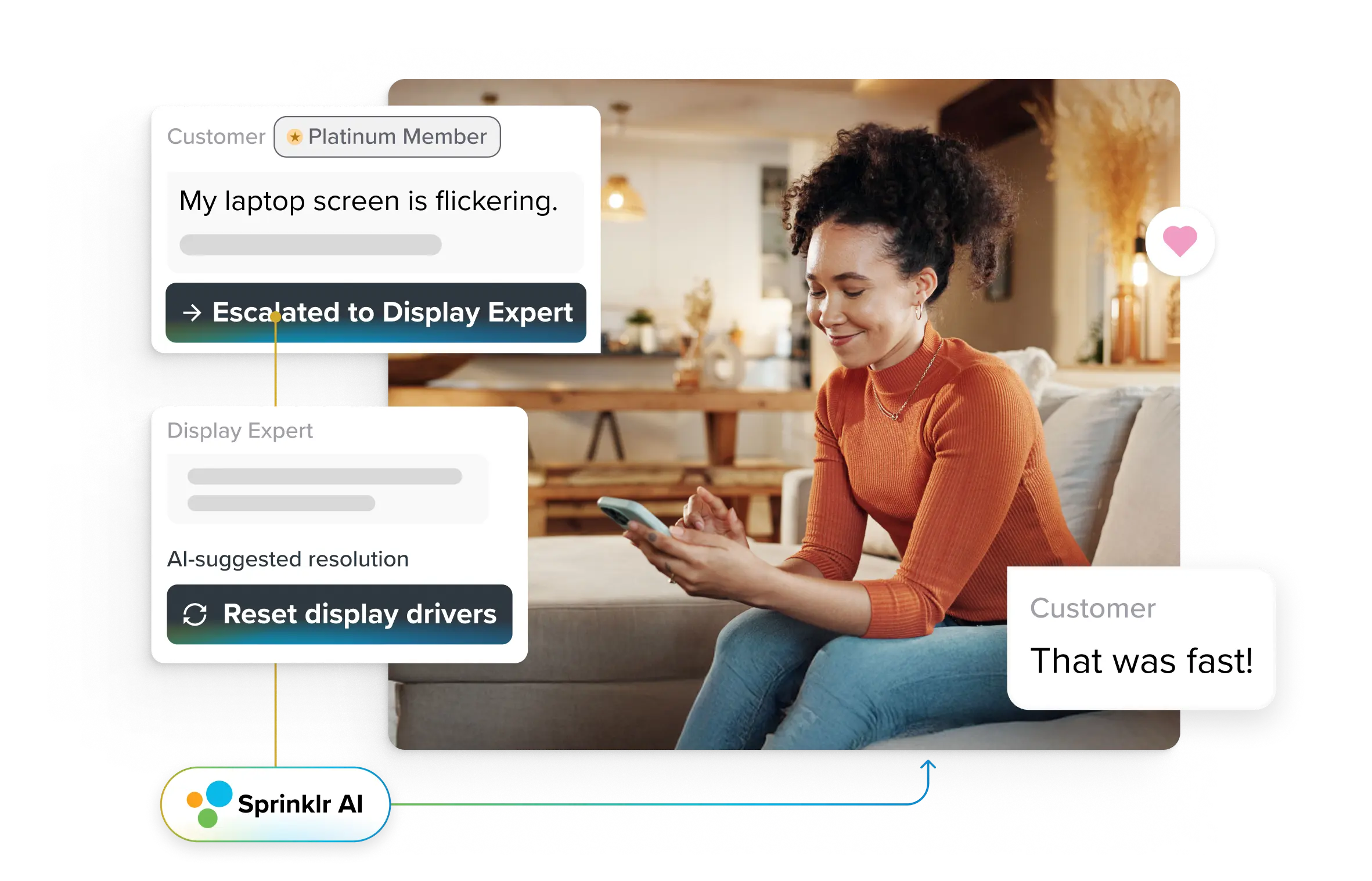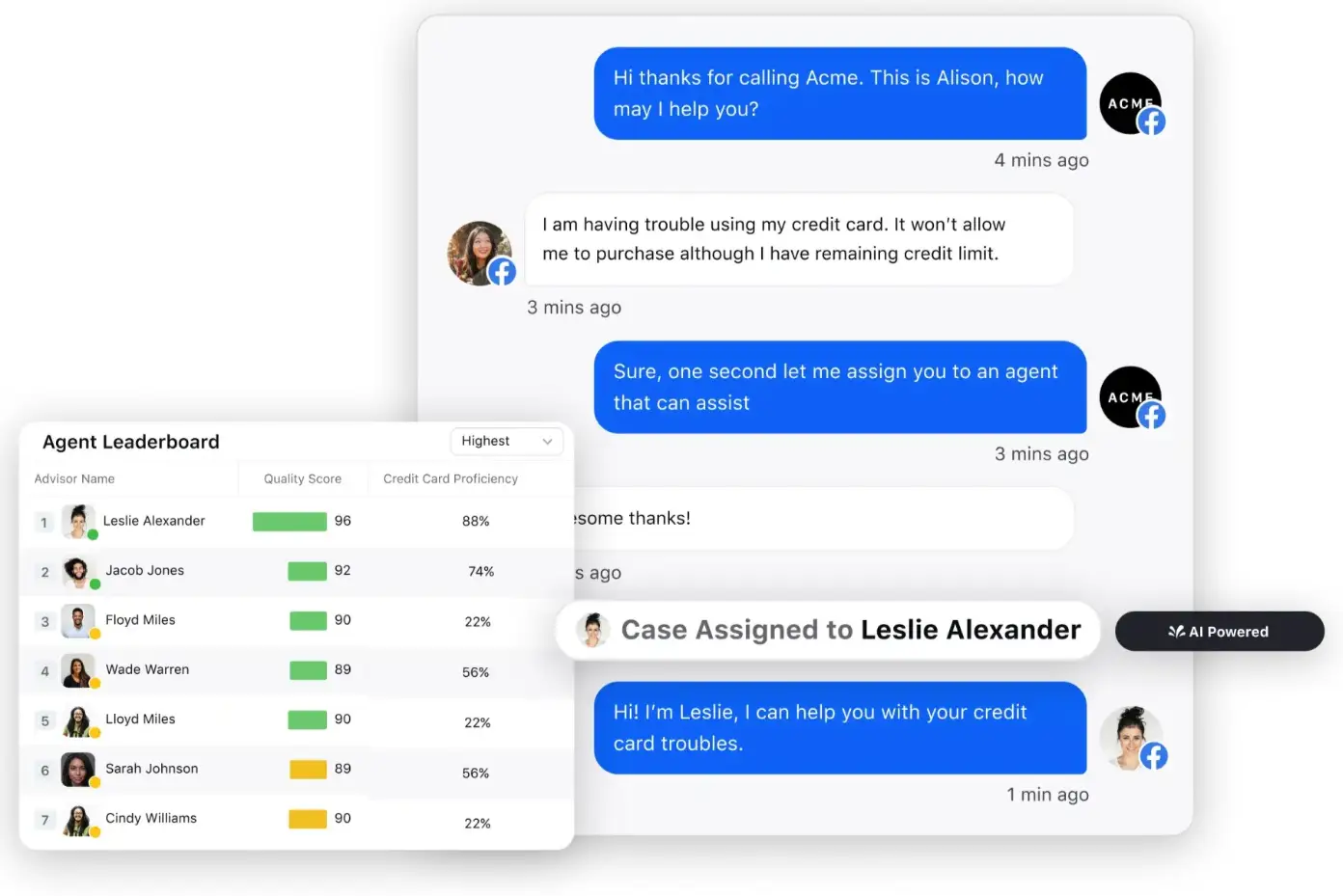Transform CX with AI at the core of every interaction
Unify fragmented interactions across 30+ voice, social and digital channels with an AI-native customer experience platform. Deliver consistent, extraordinary brand experiences at scale.

Customer Service Technology: Balancing AI and Personal Touch
Enterprise organizations are increasingly investing in modern customer service technology to meet rising expectations at scale. A recent Forrester survey reports that 40% of CX leaders plan to increase their technology investments beyond inflation this year, with a clear focus on long-term customer value and operational agility.
At the same time, customer sentiment around AI in service is far from enthusiastic. According to Gartner, 64% of customers would rather not interact with AI for support, and more than half say they would consider switching providers if they knew AI was the primary interface. The concerns center on access to human agents and a perceived decline in empathy and accountability.
This puts customer service leaders in a difficult position. There is growing pressure to automate and accelerate service delivery while customers continue to value human connection, personalized support, and accountability, especially when something goes wrong.
For enterprises already invested in cloud-based customer service infrastructure, this is familiar territory. Many have laid the foundation with flexible platforms, unified data, and intelligent workflows. But the next step is more nuanced: building a service model where AI enhances, rather than replaces, human expertise.
This blog explores what a modern customer service technology strategy looks like in 2025, how enterprises are aligning customer service automation with empathy, and the operational shifts required to sustain both.
- The key drivers of modern customer service technology
- Where AI excels in modern customer service at scale
- Why human empathy still matters despite evolving customer service technology
- How to design a scalable AI + human hybrid customer service technology model
- The future of customer service balances AI efficiency with human empathy
The key drivers of modern customer service technology
According to customer service statistics, approximately six out of ten Americans will abandon a brand they like if it consistently provides poor customer service. Nearly two out of ten will not give that brand another chance at all. This highlights the importance of ensuring that customer service technologies focus on customer convenience; otherwise, they risk becoming obsolete.
1. Demand for effortless, real-time, and omnichannel service
Customers now expect seamless, real-time support across all customer service channels—whether it's live chat, messaging, voice, or social. What they value most is speed, personalization, and continuity without needing to repeat themselves or start over.
To meet these expectations, enterprises are adopting conversational AI platforms, CRM-integrated omnichannel desktops, and journey-aware routing engines. These tools are designed to meet customers where they are while ensuring consistency and eliminating channel silos.
2. The need to scale without compromising experience
High-volume service environments face a dual mandate: reduce operational costs while improving key CX metrics like CSAT, NPS, and first contact resolution.
This has accelerated the shift toward automation-first operating models, where AI-driven self-service, intelligent IVRs, and proactive messaging handle routine interactions and deflect avoidable volume. The result is scalable customer service operations that preserve the quality of human support for higher-value cases.
3. Rising expectations for proactive and predictive support
A Gartner survey reports that 71% of B2C and 86% of B2B customers expect brands to know their details in every interaction. Customers increasingly expect brands to anticipate their needs, surface relevant support before issues escalate, and personalize outreach based on past behaviors.
In response, enterprises are investing in real-time data pipelines, predictive analytics, and AI-driven insights to shift from reactive support to proactive customer engagement — alerting customers before outages, offering help before complaints arise, and delivering knowledge before confusion occurs.
4. Agent experience as the CX multiplier
Service quality is closely tied to agent experience. When agents are forced to toggle between fragmented tools, battle incomplete data, or work in reactive mode, both resolution speed and customer empathy suffer.
Modern CCaaS platforms are focusing on agent enablement with unified desktops, AI copilots, guided workflows, and internal collaboration tools. These reduce cognitive load and streamline resolution, enabling agents to deliver fast, informed, and empathetic support. An empowered agent doesn’t just resolve faster; they humanize the experience, and that shows up directly in outcomes.
5. Operational efficiency and cost containment
Enterprise contact centers continue to face pressure to drive down cost-to-serve while improving service consistency. This has led to a renewed focus on streamlining operations, eliminating redundant processes, and automating routine tasks. Technologies such as dynamic routing, workflow automation, and AI-driven decision-making are enabling leaders to strike a balance between cost and quality.
Where AI excels in modern customer service at scale
AI is no longer an experimental layer on top of customer service. It has become a fundamental force behind how enterprises deliver speed, scale, and consistency in today’s complex service environments. But its value is not universal. AI works best when applied with precision to specific, high-leverage use cases.
Here are the areas where AI excels, particularly in large-scale, high-volume contact center operations:
- Intelligent self-service that actually resolves
AI-powered virtual agents and conversational bots have evolved well beyond scripted FAQs. Today, they can understand natural language, detect intent, and provide contextual resolutions, whether it’s processing a refund, checking order status, or updating account details.
More importantly, modern AI systems are now connected to backend systems via APIs, allowing them to execute actions, not just deliver answers. That’s what turns self-service from a deflection tool into a resolution engine.

- Real-time agent assistance
While customers want fast answers, agents often struggle to find the right information quickly. AI-powered agent assist software fills that gap with real-time suggestions, next-best actions, and contextual snippets based on ongoing analysis of the conversation.
Whether it’s auto-summarizing a long customer history, surfacing relevant articles from the knowledge base, or generating compliant responses, AI copilots empower agents to stay focused on resolution instead of navigating systems.

- Predictive routing and dynamic workflows
AI analyzes historical data, customer profiles, sentiment, and real-time context to route interactions more intelligently. Instead of static skill-based routing, predictive models ensure that the right agent — with the right expertise and capacity — gets the right interaction at the right moment. This minimizes transfers, reduces average handle time, and improves first-contact resolution.
- Conversation summarization and post-interaction insights
Contact centers generate thousands of hours of voice and chat data daily, but manually reviewing that data isn’t scalable. AI excels at real-time transcription, summarization, and tagging, making every conversation searchable, analyzable, and usable. This not only saves time on after-call work but also feeds into coaching, QA, and compliance programs, automatically helping leaders identify performance trends and emerging customer issues at scale.
- Proactive service and journey interruption prevention
By monitoring behavioral signals, account activity, or product usage patterns, AI systems can proactively trigger service interventions before a customer even contacts support.
For example, surfacing how-to guidance when usage patterns signal friction or sending a preemptive status update before a missed delivery becomes a complaint. This is where AI shifts service from reactive to preventative.
- Sentiment detection and emotion analysis
AI now plays a crucial role in real-time sentiment analysis, detecting customer frustration, confusion, or urgency across voice, chat, and email channels. These signals can trigger real-time escalation, supervisor intervention, or post-interaction follow-ups that preserve customer relationships.
For enterprise contact centers handling sensitive, high-stakes conversations (e.g., healthcare, banking), this layer of emotional intelligence brings critical nuances to service delivery.
💡Do you know
Sprinklr's AI-powered conversational analytics software monitors live customer interactions to detect potential service breakdowns, such as SLA breaches, low predicted CSAT scores or emotional distress. When triggered, the system auto-alerts supervisors and enables proactive intervention to safeguard experience and loyalty.

Why human empathy still matters despite evolving customer service technology
According to Gartner, half of the companies that plan to “significantly reduce” their customer service workforces will likely reverse those decisions by 2027. The reason is that AI still cannot replicate essential human capabilities.
“While AI offers significant potential to transform customer service, it is not a panacea. The human touch remains irreplaceable in many interactions, and organizations must balance technology with human empathy and understanding.”
Kathy Ross, Senior Director Analyst Gartner
Most enterprises' future does not lie between AI and human systems. It lies in a hybrid model that incorporates both aspects. Here's why human empathy remains mission-critical:
AI delivers efficiency but emotional engagement is still human
A 2024 study published in the European Journal of Management and Marketing (focused on hypermarket retail) found that while AI-driven services improved efficiency and reduced customer effort, they failed to significantly enhance personalization, emotional connection, or perceived service quality.
Why efficiency alone isn’t enough:
- Automation handles volume and resolves routine issues, but it doesn’t create meaningful, trust-based interactions.
- Escalations, complaints, and personalized service requests demand empathy, active listening, and discretion capabilities that only humans can offer.
- Over-reliance on AI can lead to robotic, impersonal experiences, especially in moments that require reassurance, creativity, or sensitivity.
Trust and loyalty depend on human connection
A 2023 paper published in the Journal of Artificial Intelligence and Cloud Computing highlights that while AI excels at automating tasks and delivering personalized recommendations, it cannot provide the empathy and emotional connection needed to build true customer loyalty.
Why empathy drives trust and loyalty in customer service:
- Customers trust brands more when they feel understood and valued, especially during complex, high-stress, or emotionally charged interactions, such as refunds or product replacements.
- Human agents can read between the lines, recognize emotions, and adapt tone and language in real-time, something generative AI still struggles to do reliably. Read Generative AI in Customer Service: 6 Use Cases & 10 Tips
- Enterprises that prioritize emotional intelligence experience higher customer retention, greater advocacy, and long-term business value — outcomes that are difficult to achieve through automation alone.
Human-centered design is critical for AI success
A 2023 empirical study published in IEEE (focused on online banking in Albania and Cyprus) found that while digital assistants improved convenience, genuine empathy, and human-centered design were essential to meet customer expectations and build long-term trust.
What does this mean for customer service strategy?
- AI systems that ignore emotional nuance risk frustrating customers, especially when the stakes are high or the issue is complex.
- The most effective service experiences are designed to augment human capabilities, not sideline them.
- Human-centered AI seamlessly escalates to agents when empathy is required, supports emotional intelligence, and adapts to context, not just scripts.
Consider the example of McDonald’s, which discontinued its AI-powered drive-thru ordering after repeated customer frustrations and operational breakdowns went viral.
However, the same technology works for White Castle, as the restaurant chain continues to scale its AI order assistants across more than 100 locations, completing over 90% of orders without agent involvement. (Source: The New York Times.)
Real-world scenarios where AI alone falls short
Research across various sectors, including retail, banking, and e-commerce, consistently shows that customers expect authentic empathy and nuanced support during complex, emotionally charged, or high-stakes moments.
Where only humans deliver satisfactory outcomes:
- Sensitive complaints, escalations, and crisis events require the discretion and emotional intelligence only human agents can offer.
- Life events, high-value transactions, and moments of vulnerability require adaptive, context-aware communication that exceeds the capabilities of scripted or generative AI alone.
- Customers quickly notice when responses feel generic or tone-deaf, eroding customer trust and brand loyalty.
Klarna’s experience illustrates this shift, which faced backlash after replacing hundreds of support staff with AI. Complaints surged, and satisfaction dropped as AI struggled with emotional and complex queries. The company has since reversed course, rehiring agents to restore service quality and rebuild customer trust.
💡Good Read: The Convenience Chronicles: Shep Hyken on Unlocking Customer Trust and Loyalty
How to design a scalable AI + human hybrid customer service technology model
Here is a step-by-step guide to building a hybrid (AI + human) customer service technology stack.
Step 1: Define the role of AI vs. humans in your service journey
Before deploying AI tools or restructuring support operations, enterprises must first answer a fundamental question:
“Where should AI take the lead, and where is human intervention essential?”
This clarity is the foundation of any scalable hybrid model. Without it, you risk automating the wrong experiences or underutilizing AI in high-impact areas.
📌 How to start: Map your end-to-end service journey
Begin by breaking down the customer lifecycle into clear interaction types. Categorize each by:
- Complexity (simple vs. multi-step)
- Emotional weight (neutral vs. high-stress)
- Business risk (low-value vs. high-value impact)
- Resolution pattern (standardized vs. case-specific)
Then, assign ownership: AI, human, or hybrid.
Interaction type | Primary owner | Why |
Password reset / Order status check | AI | High volume, low complexity — AI handles instantly with minimal risk. |
Delivery delay notification | AI (proactive) | Can be triggered automatically via API + personalized message, reducing inbound calls. |
Subscription upgrade inquiries | Hybrid | AI collects intent and customer data → Human closes sale with tailored recommendations. |
Billing dispute / Overcharge complaint | Human | Requires empathy, context review, and case-specific discretion. |
Fraud concern or account lockout | Human | High-stakes, emotionally charged, often complex – needs nuanced, sensitive handling. |
Loyalty program explanation | AI with fallback | AI answers FAQs; escalates if the customer is confused or needs personalized assistance. |
Technical troubleshooting | Human | Complexity and branching logic require expert understanding and adaptive problem-solving |
💡 Expert Advice
Let AI own the "front door", but not the whole house. In most mature models, AI acts as the first point of contact, gathering intent, verifying identity, and offering instant answers where possible. But it should always know when to get out of the way.

Step 2: Establish tiered service layers, not silos
Once you've defined where AI and humans each add the most value, the next step is to architect those capabilities into a scalable, layered model — one that routes each interaction to the most appropriate resource in real-time. Think of this as moving from static channels and team handoffs to a smartly tiered orchestration system, where AI and humans operate as fluid layers and not disconnected silos.
📌What is a tiered service model in a hybrid context?
A tiered model structures service delivery across progressive levels of automation and expertise, aligned to complexity, customer intent, and emotional nuance.
Here's what a modern three-tier hybrid model typically looks like:
Tier | Use Cases | Tech Enablement |
Tier 0 Primary handler: AI-led self-service | FAQs, status updates, simple troubleshooting, account info | NLP-powered chatbots, conversational IVRs, knowledge bases |
Tier 1 Primary handler: AI-augmented human agents | Billing inquiries, plan changes, product how-tos | Unified desktop, AI agent assist, next-best actions, co-pilot |
Tier 2 Primary handler: Senior agents / specialists | Escalations, complaints, fraud, VIP or sensitive cases | Full case context, customer journey view, collaboration tools |
💡Bonus Tip: Design principles for effective tiering
- Don’t route by channel; route by context
Instead of thinking of “chat teams” or “email teams,” build workflows that assess the interaction’s intent and complexity, then route it dynamically to the appropriate tier.
Example: A customer starts a chat with a subscription question → The AI identifies upsell potential and routes the conversation to a Tier 1 human agent, providing AI-suggested options and historical purchase data.
- Build smart escalation, not just handoff
Escalation should never feel like a reset. Design AI systems to:
Auto-summarize previous interactions
Attach relevant metadata (e.g., sentiment, last issue)
Pre-fill agent screens with journey context
This minimizes repetition and frustration, which is critical for Tier 1 to Tier 2 transfers.
- Avoid dead ends in Tier 0
No customer should feel “trapped” in a chatbot. Build graceful fallback paths when:
Confidence score is low
Sentiment drops
Time-to-resolve exceeds threshold
This builds trust and preserves brand reputation.
- Reinforce the loop with data and feedback
Each tier generates valuable insights. Feed Tier 2 case learnings back to AI training models, update knowledge bases based on real escalations, and track tier-to-tier movements to improve routing logic.
Step 3: Implement AI with embedded human-centered design
Human-centered AI focuses not just on what the AI can do, but also on how it makes people feel while doing it. It prioritizes trust, clarity, and care in every interaction.
This means:
😊 Sentiment recognition and emotional intelligence
- Use real-time sentiment analysis to detect frustration, hesitation, or urgency.
- Trigger adaptive behaviors (e.g., escalation, tone adjustment, slower pacing).
- Pair this with confidence scoring to avoid delivering inaccurate or tone-deaf responses.
Example: If a customer repeatedly asks the same question, the AI recognizes confusion and offers to connect with a human agent while summarizing the conversation so far.
🔁 Design for seamless escalation, not reset
- Ensure AI can pass full context, such as customer history, bot transcript, and sentiment tags, to human agents.
- Avoid making customers start from scratch or re-explain their issues.
- Set up proactive escalation rules (e.g., for VIP customers, high-risk transactions, or negative sentiment) to ensure timely responses.
💡Handoffs must feel like a continuation, not a break.
Sprinklr’s conversational AI platform is designed to keep the human experience at the center of automation. Built on a unified architecture, it enables bots to work seamlessly with intelligent routing and case management tools, ensuring every escalation reaches the right agent with full context, including conversation history, sentiment cues, and customer profile data.
No restarts. No friction. Just smooth,emotionally aware handoffs that feel like a natural continuation, not a cold transfer.

⚓ Transparency and customer control
- Let customers know when they’re speaking with a bot and clearly signal when they’ve transitioned to a human.
- Offer opt-outs, like “Talk to an agent” or “Escalate to support,” early in the flow.
- Don’t bury escalation behind unhelpful decision trees.
Step 4: Equip agents with real-time assistance and intelligence
In a hybrid AI + human service model, agents need real-time intelligence, such as context, insights, and suggestions, served at the right moment without the cognitive overload of searching across multiple systems. Here are a few tools that are instrumental in delivering memorable customer service.
Key capabilities | Strategic impact |
Reduces time spent toggling between systems. Centralizes customer data and context. | |
AI-powered agent assist | Speeds up case handling with suggested responses, next-best actions, and sentiment cues. |
Contextual knowledge retrieval | Surfaces relevant knowledge in real time, so agents focus more on conversations, not searching. |
Auto-summarization and post-interaction workflows | Cuts after-call work by 40–60%. Reduces burnout and improves agent availability. |
Real-time quality management | Enables real-time coaching, identifies compliance risks, and drives continuous improvement. |
Step 5: Ensure cross-channel continuity and context
To deliver a service that feels seamless, regardless of the channel, you must move beyond multichannel support to true omnichannel continuity powered by real-time context.
- Persistent customer profiles and threaded conversations
- Create a unified customer record that captures all past interactions—voice, chat, messaging, social, email — in one timeline.
- Enable “channel switching” without context loss. If a chat escalates to voice, the agent should pick up mid-stream, not at square one.
- Use conversation threading so all interactions (even across time and agents) are stitched together.
- Unified routing and context-aware AI
- Design routing logic that uses customer journey data to decide where to send the interaction, not just based on channel or topic.
- AI can prioritize routing based on:
- Prior dissatisfaction signals
- Escalation history
- Purchase tier or lifetime value
- Bots and IVRs should reference previous cases or ongoing tickets to avoid “start over” loops.
📈 Outcome: Faster triage, better personalization, and fewer frustrated escalations.
- Channel-agnostic service architecture
- Build your customer service stack around journeys, not individual channels.
- Leverage a Unified-CXM platform that can orchestrate data, workflows, and conversations across channels in real-time.
- Utilize APIs and event-driven architectures to maintain system synchronization (CRM, order management, ticketing) across all touchpoints.
Step 6: Build in governance, feedback loops, and transparency
To sustain a hybrid AI-human model at scale, you must embed governance, learning loops, and transparency into the core of its service operations. Start by establishing cross-functional governance teams (CX, Ops, IT, Legal) to define policies around AI use, escalation logic, and exception handling. Ensure continuous improvement by incorporating real-world insights, such as agent notes, post-interaction surveys, and escalated cases, into AI training models and workflow updates.
Transparency is equally critical: customers should always know when they’re interacting with a bot, can escalate early, and understand how their data is being used. Most importantly, track success with a balanced scorecard. Go beyond operational metrics like resolution speed or deflection rate — include sentiment recovery, agent effort, and AI vs. human CSAT comparisons.
The future of customer service balances AI efficiency with human empathy
In today’s experience-driven economy, truly exceptional customer service hinges on the ability to blend AI-powered efficiency with authentic human empathy. Building this balance starts with a clear, future-ready strategy — reassessing your current architecture, piloting hybrid AI-human workflows, embedding governance, and continuously refining through feedback loops and performance intelligence.
Sprinklr Service is purpose-built for enterprise-scale organizations navigating complex, high-volume service environments. Powered by Sprinklr AI and AI+, it brings together the full spectrum of customer service technologies — unified agent desktops, conversational AI, smart routing, live sentiment analysis, and more — on a single, cloud-native platform. It’s the modern stack built to serve customers with sky-high expectations, those who reward great service with loyalty and broadcast poor experiences across social platforms in seconds.
See how Sprinklr can help you build a customer service model that’s fast, empathetic, and future-ready.
Frequently Asked Questions
Benefits include faster response times, reduced agent workload, consistent service and scalable operations. Drawbacks include integration challenges, over-reliance on AI and potential loss of empathy in high-stakes interactions if not managed well.
Start by training agents on how AI works, what it handles and what it doesn’t. Use live simulations with AI tools, provide playbooks and offer real-time coaching. Focus on building trust in the system and teaching agents when to rely on it and when to override it.
Set clear escalation rules based on context, emotion and intent. Use sentiment analysis, AI confidence scores, or customer inputs to trigger transfers. Always pass full conversation history so agents get context instantly and customers don’t need to repeat themselves.
Key metrics include AI containment rate, escalation rate, average handle time (AHT), CSAT and first contact resolution (FCR). Also track agent satisfaction and AI confidence scores to improve collaboration and optimize workflow.
Technologies like autonomous agents, digital twins, and proactive CX orchestration will define what’s next. Expect deeper personalization, real-time intent prediction and hyper-automated workflows across every touchpoint.








